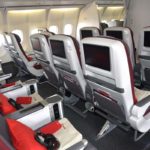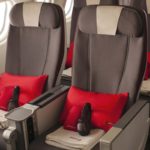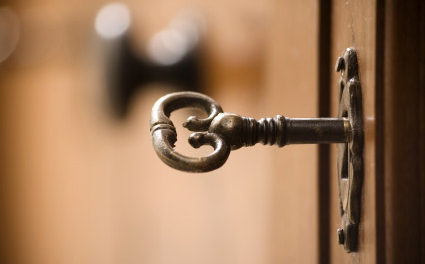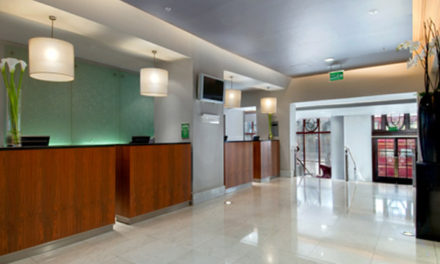Iberia Airlines replaced a section of its business class seating with a new class of seats for 37 of its long-haul aircrafts: Premium Economy Class. It’s a separate seating section for flights between Madrid and several U.S. cities, including Chicago, New York, Miami and Boston.
I flew Iberia’s Premium Economy for a recent trip to Spain (Chicago to Madrid and back). It’s an enhanced version of economy and I’d have to say it’s worth the investment if your budget doesn’t quite get you into the business class. Here’s what you should know.
The Iberia Premium Economy Seats and Amenities
The section is setup in a 2-3-2 configuration and rows are slightly angled so it gives a small sense of privacy because the seats across the aisle in each row are not fully aligned. Some other relevant highlights:
- Seat recline: Though you’re not going to expect a flatbed, seats do recline 40 percent more than in Economy (between five to seven inches).
- Separation between rows: 37 inches which is 20 percent more than in Economy.
- Wider seats: 19 inches vs. the roughly 17 inches found in Economy with headrests and footrests that are adjustable.
- Technology: Full 12-inch HD screens vs. 9-inch in Economy, with more than 600 complimentary entertainment options, noise-cancelling earphones, and charging ports for personal electronic devices (which is useful).
- International Wi-Fi: While Wi-Fi is available in Premium Economy, it is still expensive to stay connected, so I didn’t use it.
- In-flight food and beverages: You receive a complimentary drink and an upgraded meal service as part of the Premium Economy Class. My personal-sized bottle of wine was included, but other drinks may incur an extra charge, such as Spanish sherry. That should be given serious reconsideration because sherry is uniquely a Spanish spirit and that should be part of the experience when flying on a Spanish airline for those who request it. I didn’t get a chance to try the meal because I need to order a special meal to address dietary requirements (no dairy), and it was great.
- Linens: You’ll find a red Iberia blanket and basic pillow are wrapped in plastic are on your seat when you arrive (which was a comforting touch).
- Toiletry kit: You receive a basic red amenity bag that includes a toothbrush, toothpaste, socks, earplugs and an eye mask.
- Luggage and boarding: The fare covers two checked suitcases (which is helpful in those situations when you want an additional bag but don’t want to have to pay for it), priority in boarding and disembarking, and special check-in counters in the Madrid airport.
According to Gabriel Perdiguero, chief customer and business transformation officer at Iberia, the decision to implement Premium Economy was to adapt to the evolving needs of customers.
Perdiguero explained that this seat category is designed and priced to appeal to travelers leisure travelers who want an upgraded economy experience and for business travelers who work in small and medium sized organizations who do not wish to elect for Business Class.
Using Avios – Points
There’s good and bad news around points. If you’re flying Premium Economy on Iberia, you will receive between 1 and 1.5 Avois for every mile flown, depending on the fare booked.
But points people like to know how to upgrade. In the past, Economy Class passengers had an opportunity to upgrade to Business Class using fewer points. However, with the introduction of Premium Economy passengers will have to use more points for that upgrade.
An upgrade from Economy Class to Business Class on long-haul would cost, depending on the distance and the season as follows with a full fare Economy ticket (classes Y, B and H):
- Between 30,000 and 75,000 Avois during high season per leg
- Between 17,000 and 42,500 Avios during low season per leg
An upgrade from Premium Economy to Business Class on long-haul flights would cost as follows:
- Between 15,000 and 37,500 Avois during high season per leg
- Between 8,500 and 21,250 Avios during low season per leg
Iberia is not currently allowing the upgrade of Economy Class to Premium Economy Class using Avois/points at this time. However, Iberia has implemented various campaigns in its first year that allow passengers to pay for an upgrade into Premium Economy (of course, the price did vary based on route and distance).
The Verdict?
For my flight on the A330-300, there were a total of 21 Premium Economy seats (the previous business seat section had roughly 12 seats). The A340-600 has 23 Premium Economy seats and the A350-900 will have 24 seats in the new class (scheduled for 2018).
And Premium Economy, after all, is an Economy class section, so that means the additional seats also increase the demand on the Economy Class bathrooms, too (it would be my suggestion to Iberia management that Economy Premium passengers be allowed to access and share the bathroom available to business class customers — not only for their own comfort, but also to offset the added passengers who now have to rely on the economy class bathrooms (without an increase in the number of bathrooms serving that class of seat).
On the A340-600, Iberia’s biggest aircraft, there is a toilet right behind Premium Economy. But on the A330-300 aircraft, toilets are further down in the middle of Economy.
For more information on the new Premium Economy class, visit Iberia’s YouTube channel for tour through the section, or www.iberia.com.
Experience Premium Economy on Iberia Airlines:
- Iberia Airlines Premium Economy Section. Courtesy image
- Iberia Airlines Premium Economy Two-Seat Configuration. Courtesy image
- Iberia Airlines Dairy-Free Dinner on International Flight (special meal request in advance). ® 2017 Rob Hard
- Iberia Airlines Diary-Free Breakfast (special meal request in advance). ® 2017 Rob Hard
- Iberia Premium Economy 12 inch HD Screens for Entertainment. Courtesy image
- Iberia A330 – Chicago to Madrid Route. Courtesy image











